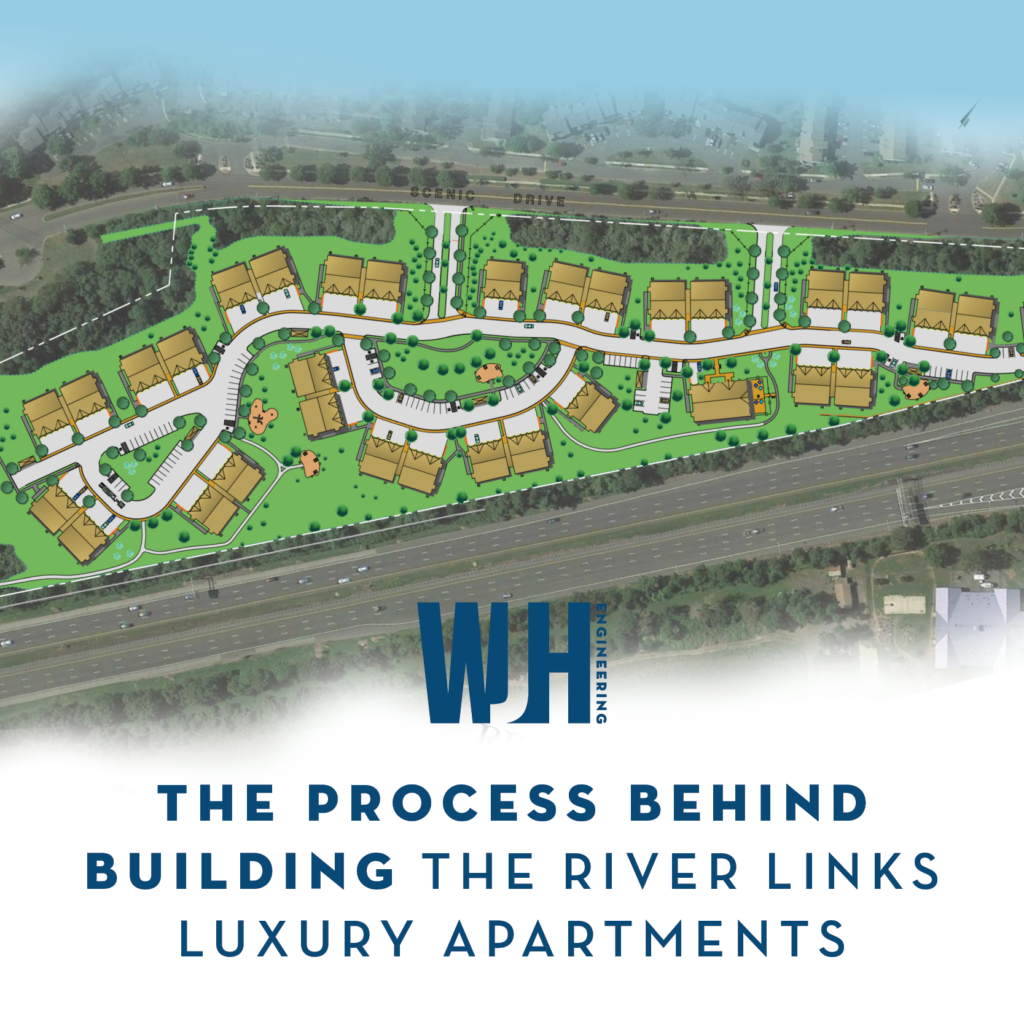The River Links community consists of 180 luxury apartment units located on 26 acres in Ewing Township, Mercer County, NJ. This was a project that took multiple decades to develop and complete. Below, we will exhibit how this project was started, developed, and completed using our 8 Step Project Completion Process that we highlighted in our blog last month!
Step1: Brainstorm an idea
Over the past several decades, there have been many conceptual ideas on developing this site with either commercial properties, single family homes, or age-restricted patio homes. Eventually, it was decided that the site should be developed with luxury apartments. However, the brainstorming does not end there!
Like many applications, there is generally a fair amount of public concern that needs to be taken into consideration so that a project is a complementary asset to its neighborhood.
This site had its fair share of concerns related to two main topics: the amount of forest clearing that would be allowed, and how to address stormwater runoff leaving the site.
The site is higher in elevation than its adjacent neighbors. Therefore, the surface and subsurface stormwater would be draining directly toward the adjacent neighbors’ basements over solid shale bedrock. Since constructing any basin or recharge system on-site would result in clearing more vegetation than we would be allowed, it was determined by our office that it would be difficult easing the residents’ concerns over stormwater by putting more water into the ground that would possibly intensify their wet basement issues.
As a team, we conceptualized an idea to move the basin off-site, downhill from the concerned residents. We located a site approximately a quarter mile away being used by another apartment community that was constructed in the early 1960’s. that we were able to utilize!
Step #2 – Meet with Municipal Professionals
Many may not know, but the path to victory during the Revolutionary War was through Ewing Township, when Washington marched his troops along the Delaware River. Due to the project’s close proximity to the river and associated canal and towpath, it came under the very strict review of the Delaware & Raritan Canal Commission. The DRCC reviewed our application for stormwater drainage, stream corridor impacts and water quality, traffic, and to a lesser degree, building materials, architectural and visual impacts and historic and natural quality conflicts.
Since the DRCC Regulations specifically requires Local and County approval prior to being voted on, periodic staff review of the technical aspects of the project were pursued frequently, in order to define the scope and reduce engineering design costs to the client. Our off-site basin was proposed to be constructed not only adjacent to a Commission regulated stream corridor that flowed “directly” into the canal, but also with a typical outfall structure discharging to the stream, which is generally not allowed. We had to make the case to the DRCC and the local municipality that this basin would treat the stormwater from our site, as well as eliminate an existing outfall and provide treatment to a large portion of the existing site that was constructed in the 1960’s. We proposed to oversize the basin in order to provide treatment to as much of the existing parking lots as possible.
Steps #3: Conduct a Property Survey
A property survey was performed by our WJH Surveying Team to provide a basis for the design that our WJH Engineering Team would later work on.
Step 4: Collaborate with Architects
Berkowsky and Associates, Inc. provided our Team with architectural plans. In collaborating with the them, we were able to decide the best location for the sanitary, water, and gas laterals exiting each building and determine the differing floor elevations of each building.
Step 5: Design the Site
While the design of the project and basin were driven by many elements associated with the stream corridor, floodplain, wetlands and buffers, the most concerning was the shale bedrock in the area of the apartments.
A detailed geotechnical investigation and mapping was performed delineating the depth of the bedrock. We then relocated the apartment buildings and the majority of the sanitary and stormwater piping above or away from the very restricted bedrock areas so that blasting would not have to be utilized. Blasting is the controlled process of cracking rock material, such as bedrock, using a small amount of explosive substances.
The off-site basin had its own challenging issues associated with making it large enough to address what we agreed to with the DRCC, which was to convey as much stormwater from the untreated existing parking lots as possible. The design of the off-site sand bottom basin, which was also on the side of a hill, required reinforced concrete walls measuring 6 to 10 feet in height.
Step 6: Submit the Plan
After all of the designs were done, our plan submissions included, but were not limited to, the following:
- Department of Environmental Protection (DEP), for Treatment Works Approval
- Mercer County Soil Conservation District, for Soil Erosion and Sediment Control Certification
- Delaware & Raritan Canal Commission (DRCC), for approval of our stormwater drainage, stream corridor impacts and water quality, traffic, and building materials
- Township of Ewing Planning and Zoning Boards for general approval
Step 7: Prepare for Construction
The construction phase of the walls for the off-site basin took over five months due to the amount of material and rebar used along with working in close proximity to adjacent residential structures. Due to permitting issues, the basin was constructed several years before the apartment complex, which was recently completed.
Step 8: Complete As-Built Plans
After construction was finished, an as-built survey was done to verify that our project was constructed with accordance to our plans.
The River Links luxury apartment community, located close to the Princeton offices and the Trenton Airport, offers a fitness center, meeting rooms, nature trails, playground structures and picnic areas with grills.
Our vision of constructing the off-site basin not only addressed the valid concerns of the adjacent resident’s basements and preserved a large area of woodland behind their homes, but also enhanced water quality at an off-site location that directly discharged to a stream. This stream flows into the canal that ultimately provides public water to the surrounding municipalities.
Contact us today to experience our 8-step process for yourself to plan your next project!



